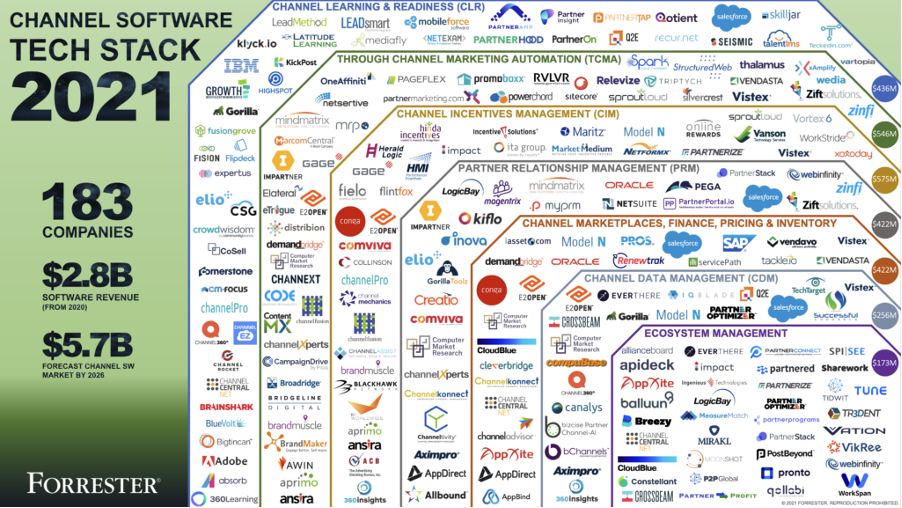Key Strategies for Optimizing Channel Sales in Manufacturing
The life of a manufacturer, especially in Europe's challenging business climate, is a never-ending cycle of strategization. As soon as production is complete, the task of delivering the products to consumers at the lowest cost begins.
Channel sales remain one of the most popular distribution and sales methods, accounting for 75% of the world's trade. With the growing number of channel partners and the increasing availability of supporting technology, manufacturers are now in an excellent position to fully derive the benefits of selling through this method.
In this article, we will discuss channel sales in manufacturing, explore the options and benefits, and recommend 3 strategies for optimizing your channel sales program.

What are channel sales in manufacturing?
Channel sales, also known as indirect or partner sales, is a B2B sales method that involves distributing products and services through other businesses, referred to as channel partners. Rather than advertising on ecommerce websites or opening new brick-and-mortar stores, channel sales allow businesses to sell through third-party entities.
Selling directly to customers allows for more control over customer experience and closer relationships with the end-users, but it also has some downsides. Maintaining internal sales and marketing teams can be expensive, and the cost implications become especially high when attempting to penetrate new regions.
Implementing channel sales allows manufacturers to leverage partners' existing strengths, easing the process and financial burden of entering new markets.
Ultimately, European manufacturers will find the most joy in combining direct and channel sales. Direct sales can effectively target niche markets and key accounts, while indirect sales expand the company's reach at low costs.
Types of channel partners
Channel partners are intermediaries between manufacturers and customers, handling various aspects of sales, marketing, and customer service.
There are different types of partners, each fulfilling a different role from the next. Here are some channel partners that are specifically useful in the manufacturing industry:
Distributors
These partners buy products in bulk from manufacturers and sell them to smaller retailers or directly to end-users. Distributors often provide additional services like product bundling, inventory management, and after-sales support.
Resellers
Resellers, also known as retailers, purchase products from manufacturers or distributors and sell them to the end-users.
Value-added resellers (VARs)
These partners enhance the products they buy from manufacturers with additional features or services, such as installation, troubleshooting, or customizations before resale.
Affiliates
Affiliate partners advertise manufacturers' products through their websites, social media, or other digital channels. Affiliates earn commissions for sales or leads generated.
Original equipment manufacturer (OEM) partners
OEM partners integrate the manufacturer's product into their product. For example, a car manufacturer might purchase a sound system from an audio equipment manufacturer to use in its vehicles.
Key benefits of channel sales
Channel sales offer comes with many benefits and is certainly an important strategy for manufacturers looking to scale. Here are some key advantages:
Expansion of market reach
Let's face it: breaking into new markets is hard. In fact, for every successful market entry, there are four other failures. There are several reasons for this, including lack of knowledge of the market and difficulty in overcoming regulatory complexities and logistical issues.
Distributors, OEM partners, and other partners solve many of these problems for manufacturers. Channel partners already have established networks and relationships in their regions of operations.
By leveraging these channels, manufacturers can enter new markets without establishing any local presence.
Increased profit margins
Working with channel partners eases new market penetration and attracts new revenue opportunities. 63.5% of companies say channel partners significantly contributed to their annual revenue, illustrating the impact of proper channel management.
In addition to bringing in more revenue, indirect sales also lower costs. Manufacturers will not need to hire more sales and marketing staff or increase ad spending to expand their reach. Hence, savings are made on employee costs and marketing, leading to higher profits.
Localized marketing and sales strategies
Channel partners have better insights and established relationships in their specific markets. This local expertise helps them tailor sales and marketing strategies to fit the cultural and economic peculiarities of their regions and meet customers' needs.
This improves promotional campaigns and increases the chances of success for manufacturers.
Access to valuable insights
Manufacturers can work with channel partners to collect valuable insights about the customers in their region and the market. This includes customer preferences, market trends, customer feedback, and competitor data, which helps manufacturers improve their products and strategies.
Scalability
Growing demands place more pressure on manufacturers to scale up operations. Channel partners can reduce the pressure by handling additional sales volume and customer support so manufacturers can focus on other aspects.
Strategies for optimizing channel sales
For all the merits of channel sales, some businesses fail to reap the benefits because they cannot construct an indirect sales strategy that works. Optimizing channel management is critical for maximizing the efficiency and effectiveness of your distribution strategy. Here are some of the best strategies to implement today:
1. Select the right partners
A channel sales program is only as good as its partners. Mismatches between manufacturers and partners are a top reason some programs fail, and misaligned goals between the participants are the root of that mismatch.
To select the right partners, the partner's business model, market strategy, and target customer base must align with your company's goals and product catalogue. Manufacturers must also weigh the partners’ strengths and weaknesses against their priorities. For example, a partner with a strong sales track record but poor after-sales support will be mismatched with a manufacturer keen on great customer experiences.
Such thorough research and careful consideration will ensure that manufacturers find long-term partners.
2. Empower partners through sales enablement
Manufacturers must realize that channel partners must be given the same attention as internal sales reps to be just as efficient. Regardless of the past sales history, partners still need training and information to sell their products.
For your sales and distribution partnerships to work, partners should be put through the sales enablement process. This starts with comprehensive onboarding and training through workshops, webinars, and regular training sessions.
During this time, manufacturers must provide partners with up-to-date sales materials such as brochures, product datasheets, case studies, presentations, and demo videos. Communication lines should always be open so partners can receive updates on product changes or new releases. Lastly, partners should be supported in technical assistance, customer service, and after-sales services.
Companies with sales enablement strategies have a 49% higher win rate on forecasted deals than those without. Therefore, manufacturers must extend their sales enablement practices to their channel partners for more efficient partnerships.
3. Leverage PRM systems for channel management
The best Customer Relationship Management (CRM) systems have Partner Relationship Management (PRM) functionality built into them. Manufacturing businesses can leverage this technology to enhance channel management further.

PRM systems come with numerous features and capabilities that can enhance partnerships. Manufacturers can leverage such tools to improve communication, onboarding, training, and workflows. PRM systems enable manufacturers to efficiently distribute leads, share training resources and marketing materials, and manage incentive programs, all within the same platform.
Additionally, manufacturers can leverage performance tracking and analytics within PRM solutions. This allows for monitoring of key performance indicators (KPIs) such as sales volume, conversion rates, market penetration, partner pipeline contribution, and many more. Both parties can have strategy meetings and make informed decisions.
Top PRM solutions for manufacturing channel sales
Salesforce CRM is one of the best examples of PRM solutions. It incorporates AI into channel management, helping to connect partners to deals using AI-powered lead scoring and generating predictive insights.
This PRM solution can power manufacturers to new heights of indirect sales profitability using a data-driven approach.

Digital interfaces for scalable growth
Optimizing channel sales is crucial for manufacturers seeking to expand their market reach and scale without necessarily hiring new staff. When well-executed, it provides an excellent path to higher profits and increased brand awareness.
From distributors to value-added resellers, different partners are available to manufacturing companies. Choosing the right partners, training them extensively, and leveraging PRM systems will ensure high-quality channel management.
Author

Christoph Wiederle
Business Director Salesforce at ACTUM Digital. You can find me on LinkedIn